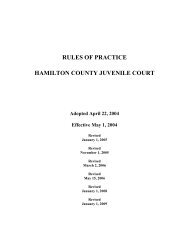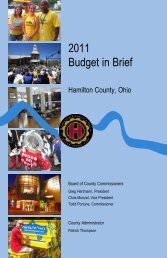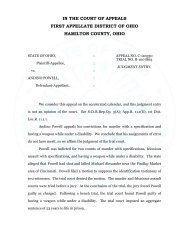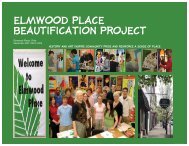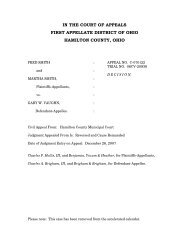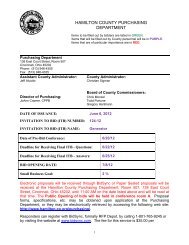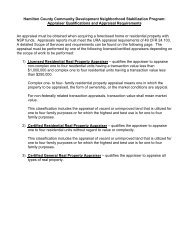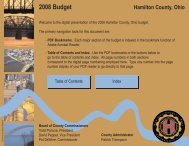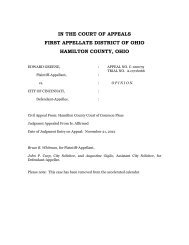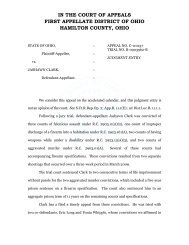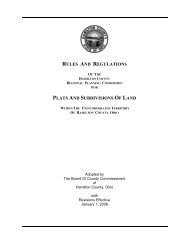Planning Commissioners' Procedures Manual - Hamilton County, Ohio
Planning Commissioners' Procedures Manual - Hamilton County, Ohio
Planning Commissioners' Procedures Manual - Hamilton County, Ohio
Create successful ePaper yourself
Turn your PDF publications into a flip-book with our unique Google optimized e-Paper software.
Rural Zoning Can's and Cant’s<br />
http://ohioline.osu.edu/cd-fact/0301.html<br />
In 1947, the <strong>Ohio</strong> General Assembly passed enabling legislation that allows cities, villages,<br />
counties, and townships to establish zoning. The procedures and methods and procedures to<br />
establish zoning are distinct. However, the content is the discretion of the people of the area.<br />
<strong>Ohio</strong>'s law is very precise and detailed. The law is designed to involve the public in the zoning<br />
process.<br />
Zoning regulation can be divided into two categories: unincorporated (rural) and municipal. This<br />
series of fact sheets will focus on rural zoning. Rural zoning concentrates on township and<br />
county zoning outside of municipalities (village, town, city).<br />
Township zoning is the responsibility of township trustees. <strong>County</strong> zoning falls into the<br />
jurisdiction of the county commissioners. <strong>County</strong> zoning may include all or any number of<br />
townships in the county. <strong>County</strong> zoning includes a uniform zoning text administered countywide.<br />
All zoning issues are accepted or rejected by referendum.<br />
Discussions of zoning by rural residents constantly provoke differences of opinion about what<br />
zoning is, what it can do, and what it cannot do. In 1947, the <strong>Ohio</strong> legislature gave counties and<br />
townships the legal authority to proceed with rural zoning as long as it was based upon a<br />
comprehensive plan. The legislation that created rural zoning is quite precise but<br />
misunderstandings can occur. The purpose of this fact sheet is to outline items that rural zoning<br />
can do, as well as what rural zoning can not do.<br />
What Zoning Can Do<br />
At it's best rural zoning can:<br />
• assist community economic growth by helping reserve adequate and desirable sites for<br />
industrial and commercial users<br />
• protect the public's property from inconsistent or harmful uses<br />
• help keep rural areas from becoming dumping grounds for businesses which are trying to<br />
avoid municipal regulations<br />
• protect individual property owners from harmful or undesirable uses of adjacent property<br />
• provide orderly and systemic transition in land use that benefits all land uses through<br />
public hearings and local decisions<br />
• help prevent objections to normal and necessary farming operations which can take place<br />
when residential developments move into agricultural areas in an unplanned fashion<br />
• make a community more attractive by assisting the preservation of open space, unique<br />
natural resources, and natural terrain features<br />
• protect present and future industry from harassment by residential neighbors by<br />
informing residents where industry will be allowed to develop in an orderly fashion<br />
• serve as a tool to put into effect plans for future development<br />
• allow for important community decisions to be made within the community



